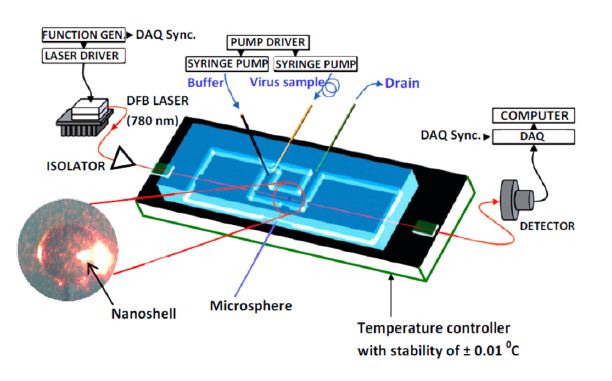Detecting single samples of smallest known viruses
August 30, 2012

Microfludic WGM biosensor with the image of an assembled WGM-h resonator. (credit: V. R. Dantham, S. Holler, V. Kolchenko, Z. Wan, S. Arnold/Applied Physics Letters)
By affixing nanoscale gold spheres onto a microscopic bead of glass, researchers have created a super-sensor that can detect even single samples of the smallest known viruses.
The sensor uses a peculiar behavior of light known as “whispering gallery mode,” named after the famous circular gallery in St. Paul’s Cathedral in London, where a whisper near the wall can be heard around the gallery due to frequency resonance.
In a similar way, waves of light are sent whirling around the inside of a small glass bead (nanoshell), resonating at a specific frequency. Just as a small object on a vibrating violin string can change its frequency — ever so slightly — so too can a virus landing on the sensor change the resonant frequency of the light.
With the initial glass sphere, researchers were able to detect resonance frequency shifts for viruses about the size of influenza, a relatively large virus. The system, however, was not sensitive enough to detect anything smaller, such as the Polio virus. But the researchers were able to increase the sensitivity of the device nearly 70 times by adding gold nanospheres to the surface of the glass, which created what the researchers referred to as “plasmonic hot spots” — areas where the light waves coupled with waves of electrons.
This hybrid sensor detected the presence of the MS2 virus — the lightest known RNA viruses — and was also able to determine the weight of the virus by measuring the precise frequency shift of the light.
With a few minor adjustments, the sensor should also be able to detect single proteins, such as cancer markers that appear in the blood long before outward signs of cancer can be detected.